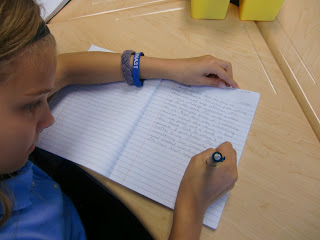 |
| Welcome Back! |
It was great to see so many of you at Back to School Night! I hope that you are as excited as I am about your child's sixth-grade year. We are going to do lots of reading, lots of writing, and lots of thinking. While it is my responsibility to educate students for the world they will be entering, I also believe in balance. Writer's notebooks, pens and pencils, and iPads all have their respective places in my curriculum.
Being with you last night reminded me of my middle and high school years. On the ride home, I reflected on those teachers that impacted my life. Ms. Kohnke, my AP English teacher, believed in me. She trusted me with responsibility and stoked my interests in writing, reading, and good literature. She was also the first teacher I got to know outside of school. I remember how surreal it was for me at the time - Ms. Kohnke was actually a human being with a house and a car! In fact, it was a compact pickup truck. Picturing her driving that red Toyota still makes me smile!
My history teacher, Mr. Goldman, affected me in a different way. He was passionate about what he taught, and I enjoyed his sarcastic wit. To this day, I can clearly hear the excitement in his voice as he explained the workings of capitalism, socialism, and communism. Without any fanfare, Mr. Goldman had a unique ability to get students interested in his class. Recently, we reconnected and went out for lunch. It had been 22 years since I had since him last. Amazingly, he hadn't aged a bit!
These two memories reminded me of the importance of my job. To be a trusted partner in your child's education is an honor. While I can never be a Ms. Kohnke or a Mr. Goldman, I am privileged to be a part of an educational community that cares so deeply about your children. Here's to a fruitful and inspiring year!
-Brad
My history teacher, Mr. Goldman, affected me in a different way. He was passionate about what he taught, and I enjoyed his sarcastic wit. To this day, I can clearly hear the excitement in his voice as he explained the workings of capitalism, socialism, and communism. Without any fanfare, Mr. Goldman had a unique ability to get students interested in his class. Recently, we reconnected and went out for lunch. It had been 22 years since I had since him last. Amazingly, he hadn't aged a bit!
These two memories reminded me of the importance of my job. To be a trusted partner in your child's education is an honor. While I can never be a Ms. Kohnke or a Mr. Goldman, I am privileged to be a part of an educational community that cares so deeply about your children. Here's to a fruitful and inspiring year!
-Brad


